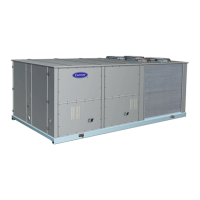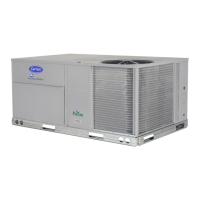63
GENERAL FAN PERFORMANCE NOTES:
1. Interpolation is permissible. Do not extrapolate.
2. External static pressure is the static pressure difference between the return duct and the supply duct plus the static pressure
caused by any FIOPs or accessories.
3. Tabular data accounts for pressure loss due to clean filters, unit casing, and wet coils. Factory options and accessories may add
static pressure losses. Selection software is available, through your salesperson, to help you select the best motor/drive combina-
tion for your application.
4. The Fan Performance tables offer motor/drive recommendations. In cases when two motor/drive combinations would work,
Carrier recommends the lower horsepower option.
5. For information on the electrical properties of Carrier motors, please see the Electrical information section of this book.
6. For more information on the performance limits of Carrier motors, see the application data section of this book.
7. The EPACT (Energy Policy Act) regulates energy requirements for specific types of indoor fan motors. Motors regulated by
EPACT include any general purpose, T-frame (three-digit, 143 and larger), single-speed, foot mounted, polyphase, squirrel cage
induction motors of NEMA (National Electrical Manufacturers Association) design A and B, manufactured for use in the
United States. Ranging from 1 to 200 Hp, these continuous-duty motors operate on 230 and 460 volt, 60 Hz power. If a motor
does not fit into these specifications, the motor does not have to be replaced by an EPACT compliant energy-efficient motor.
Variable-speed motors are exempt from EPACT compliance requirements.
APPENDIX C — FAN DATA

